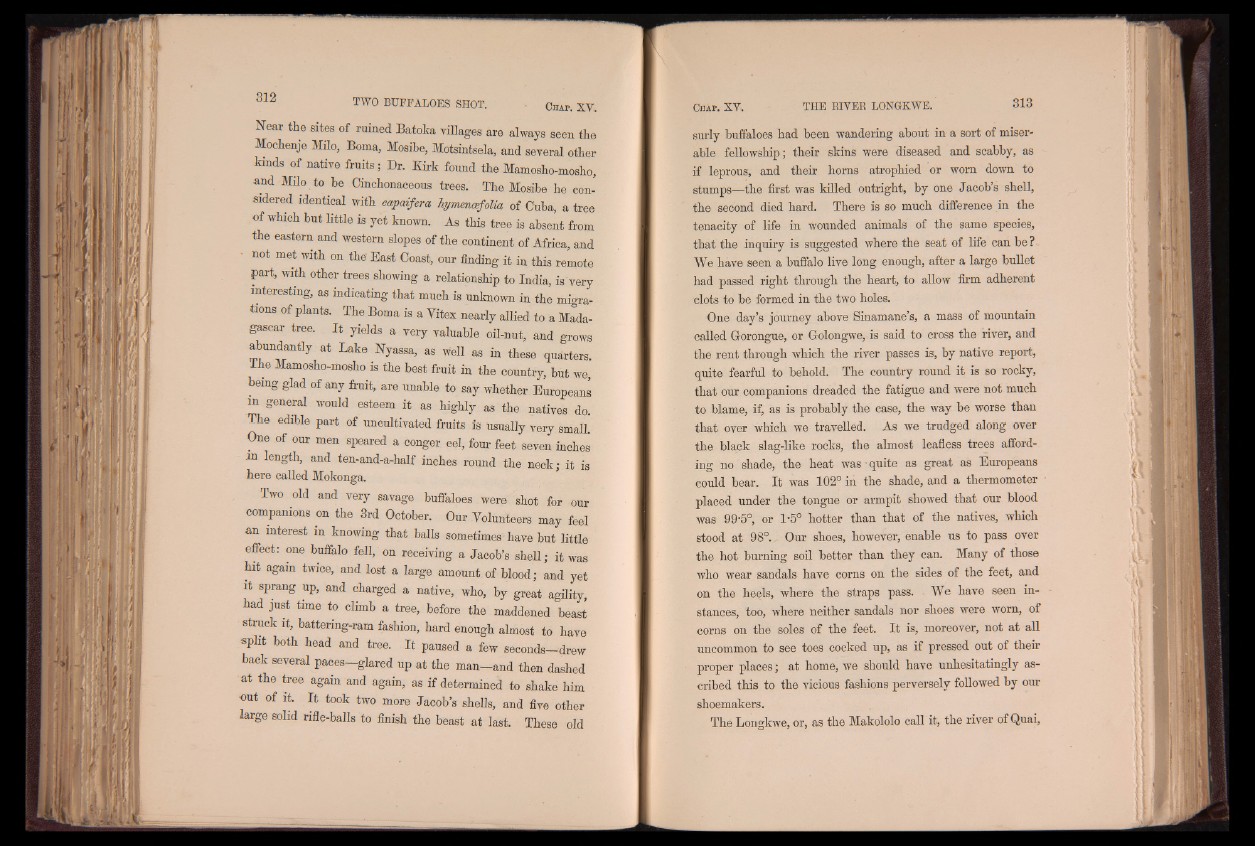
Near the sites of ruined Batoka villages are always seen the
Mochenje Milo, Boma, Mosibe, Motsintsela, and several other
kinds of native fruits; Dr. Kirk found the Mamosho-mosho,
arid Milo to be Cinchonaceous trees. The Mosibe he considered
identical with capaifera hymencefolia of Cuba, a tree
of which but little is yet known. As this tree is absent from
the eastern and western slopes of the continent of Africa, and
not met with on the' East Coast, our finding it in this remote
part, with other trees showing a relationship to India, is very
interesting, as indicating that much is unknown in the migrations
of plants. The Boma is a Yitex nearly allied to a Madagascar
tree. I t yields a very valuable oil-nut, and grows
abundantly at Lake Nyassa, as well as in these quarters
The Mamosho-mosho is the best fruit in the country, but we,
being glad of any fruit, are unable to say whether European
m general would esteem it as highly as the natives do.
The edible part of uncultivated fruits is usually very smalL
One of our men speared a conger eel, four feet seven inches
in length, and ten-and-a-half inches round the neck; it is
here called Mokonga.
Two old and very savage buffaloes were shot for our
companions on the 3rd October. Our Volunteers may feel
an interest in knowing that balls sometimes have but little
effect: one buffalo fell, on receiving a Jacob’s shell; it was
hit again twice, and lost a large amount of blood; and yet
it sprang up, and charged a native, who, by great agility,
had just time to climb a tree, before the maddened beast
struck it, battering-ram fashion, hard enough almost to have
split both head and tree. I t paused a few seconds—drew
back several paces—glared up at the man—and then dashed
at the tree again and again, as if determined to shake him
out of it. I t took two more Jacob’s shells, and five other
large solid nfle-balls to finish the beast at last. These old
surly buffaloes had been wandering about in a sort of miserable
fellowship; their skins were diseased and scabby, as
if leprous, and their horns atrophied or worn down to
stumps—the first was killed outright, by one Jacob’s shell,
the second died hard. There is so much difference in the
tenacity of life in wounded animals of the same species,
that the inquiry is suggested where the seat of life can be ?
We have seen a buffalo live long enough, after a large bullet
had passed right through the heart, to allow firm adherent
clots to be formed in the two holes.
One day’s journey above Sinamane’s, a mass of mountain
called Gorongue, or Golongwe,.is said to cross the fiver, and
the rent through which the river passes is, by native report,
quite fearful to behold. The country round it is so rocky,
that our companions dreaded the fatigue and were not much
to blame, if, as is probably the case, the way be worse than
that over which we travelled. As we trudged along over
the black slag-like rocks, the almost leafless trees affording
no shade, the heat was quite as great as Europeans
could bear. I t was 102° in the shade, and a thermometer
placed under the tongue or armpit showed that our blood
ivas 99-5°, or 1-5° hotter than that of the natives, which
stood at 98°. Our shoes, however, enable us to pass over
the hot burning soil better than they can. Many of those
who wear sandals have corns on the sides of the feet, and
on the heels, where the straps pass. • We have seen instances,
too, where neither sandals nor shoes were worn, of
corns on the soles of the feet. I t is, moreover, not at all
uncommon to see toes cocked up, as if pressed out of their
proper places; at home, we should have unhesitatingly ascribed
this to the vicious fashions perversely followed by our
shoemakers.
The Longkwe, or, as the Makololo call it, the river of Quai, O * *